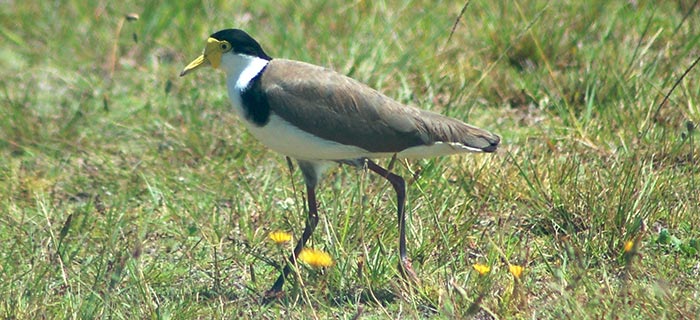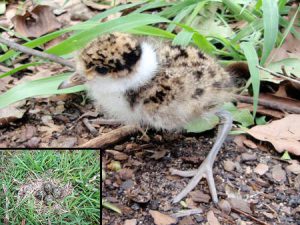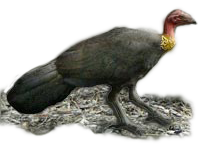
(Vanellus miles)
Other Common Names: Plover, Masked Plover, Spur-winged Plover
Physical Description
Masked Lapwings or Plovers as they are also known are a medium sized long-legged distinctive bird that reaches an average size of 35-38cm in length. The head is black with characteristic fleshy yellow wattles that mask the face and droop down. The back is sandy brown and the neck and underparts are white with long red legs. The wings have a bony spur protruding from the shoulder which is visible at close range. There is little difference in colour between the males and females however juveniles are duller in colouration and the top of the wings are mottled.
Ecology
Occurring through most of Australia except the central and westerly parts of Western Australia and South Australia, Masked lapwing’s occupy a wide range of natural and man-made open environments that are often situated close to wetlands. They are commonly observed in grasslands, farmlands, estuaries and open suburban areas such as golf courses, sports fields and lawns. Their diet consists on a variety of invertebrates such as worms, millipedes and grasshoppers but will also consume plant matter including seeds and leaves.
Breeding
 Breeding occurs from June through to November or December however they may breed in any month if conditions are suitable. Masked lapwings nest in open areas which allows for the bird to view its surroundings. A hollow is scraped into the ground and lined with small pieces of dry vegetation collected from the immediate vicinity. Clutch size usually consists of 3 or 4 eggs which are pear shaped and a yellowish-olive to light-brownish-olive colour. Both sexes will take turn to incubate the eggs which takes 28-30 days. The chicks have downy feathers when they are born and are capable of feeding themselves within hours after hatching. After 8-10 hours they become independent and can breed in their first year
Breeding occurs from June through to November or December however they may breed in any month if conditions are suitable. Masked lapwings nest in open areas which allows for the bird to view its surroundings. A hollow is scraped into the ground and lined with small pieces of dry vegetation collected from the immediate vicinity. Clutch size usually consists of 3 or 4 eggs which are pear shaped and a yellowish-olive to light-brownish-olive colour. Both sexes will take turn to incubate the eggs which takes 28-30 days. The chicks have downy feathers when they are born and are capable of feeding themselves within hours after hatching. After 8-10 hours they become independent and can breed in their first year
Living alongside Plovers
How can I deter these birds from my home?
Masked lapwings will rarely make contact and rely upon their distinctive call to ward off predators. There is a widely believed myth that the spur of plover contains venom and they use this in attacks however this in incorrect. The risk of damage to the wings is increased by such attacks and as such they depend upon their vocalisations as deterrents.
All wildlife is protected within Queensland and any attempt to harm or remove animals without the correct permits and licences is illegal. This also includes tampering with nesting and breeding sites. It is important to remember that wildlife will take advantage of suitable conditions available to them when their natural habitat has been modified.
Where possible avoid areas where the birds are swooping. If it is on a sports field or in your own backyard avoid the area as much as possible. Once the chicks have hatched the birds will move on of their own accord.
Keeping grass trimmed may help in preventing the birds from nesting and foraging and encouraging them to move elsewhere.
Like magpies and butcherbirds utilise hats, umbrellas and keeping your eye on the bird can help in deterring attacks. Do not harass the birds as they may become increasingly defensive and lead to an increase of attacks.
Advice & Relocation
Our licensed professionals can provide you with ecological advice and mitigation of masked lapwings. Mitigation of these birds is conducted in accordance with permits and licences issued by the Department of Environment and Heritage Protection (DEHP) and Animal Ethics Committee (AEC). These permits and licences are only issued where the knowledge and suitability requirement to manage plovers effectively has been met under stringent conditions.
Give your local swooping plover specialist a call today on 0439 506 874 or you can email us at brs@qfc.com.au



